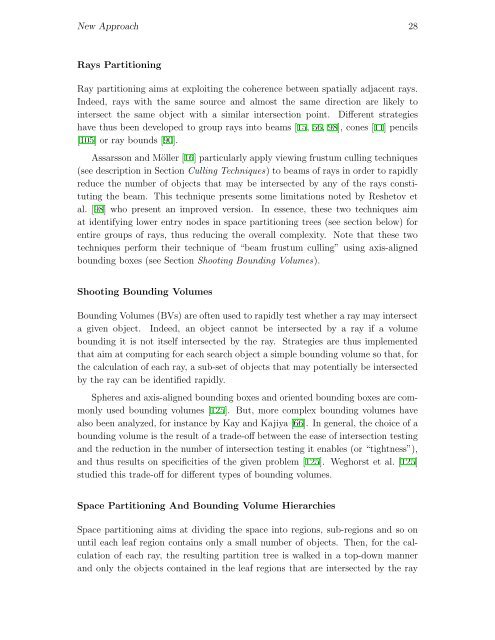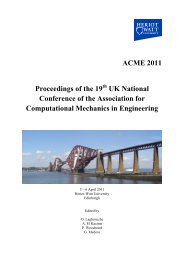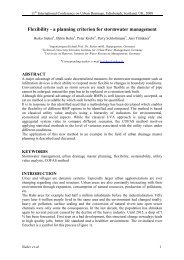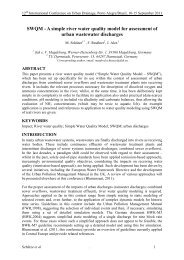PhD Thesis - Automated Recognition of 3D CAD Model Objects in ...
PhD Thesis - Automated Recognition of 3D CAD Model Objects in ...
PhD Thesis - Automated Recognition of 3D CAD Model Objects in ...
You also want an ePaper? Increase the reach of your titles
YUMPU automatically turns print PDFs into web optimized ePapers that Google loves.
New Approach 28<br />
Rays Partition<strong>in</strong>g<br />
Ray partition<strong>in</strong>g aims at exploit<strong>in</strong>g the coherence between spatially adjacent rays.<br />
Indeed, rays with the same source and almost the same direction are likely to<br />
<strong>in</strong>tersect the same object with a similar <strong>in</strong>tersection po<strong>in</strong>t. Different strategies<br />
have thus been developed to group rays <strong>in</strong>to beams [15, 56, 98], cones [11] pencils<br />
[105] or ray bounds [90].<br />
Assarsson and Möller [16] particularly apply view<strong>in</strong>g frustum cull<strong>in</strong>g techniques<br />
(see description <strong>in</strong> Section Cull<strong>in</strong>g Techniques) to beams <strong>of</strong> rays <strong>in</strong> order to rapidly<br />
reduce the number <strong>of</strong> objects that may be <strong>in</strong>tersected by any <strong>of</strong> the rays constitut<strong>in</strong>g<br />
the beam. This technique presents some limitations noted by Reshetov et<br />
al. [98] who present an improved version. In essence, these two techniques aim<br />
at identify<strong>in</strong>g lower entry nodes <strong>in</strong> space partition<strong>in</strong>g trees (see section below) for<br />
entire groups <strong>of</strong> rays, thus reduc<strong>in</strong>g the overall complexity. Note that these two<br />
techniques perform their technique <strong>of</strong> “beam frustum cull<strong>in</strong>g” us<strong>in</strong>g axis-aligned<br />
bound<strong>in</strong>g boxes (see Section Shoot<strong>in</strong>g Bound<strong>in</strong>g Volumes).<br />
Shoot<strong>in</strong>g Bound<strong>in</strong>g Volumes<br />
Bound<strong>in</strong>g Volumes (BVs) are <strong>of</strong>ten used to rapidly test whether a ray may <strong>in</strong>tersect<br />
a given object. Indeed, an object cannot be <strong>in</strong>tersected by a ray if a volume<br />
bound<strong>in</strong>g it is not itself <strong>in</strong>tersected by the ray. Strategies are thus implemented<br />
that aim at comput<strong>in</strong>g for each search object a simple bound<strong>in</strong>g volume so that, for<br />
the calculation <strong>of</strong> each ray, a sub-set <strong>of</strong> objects that may potentially be <strong>in</strong>tersected<br />
by the ray can be identified rapidly.<br />
Spheres and axis-aligned bound<strong>in</strong>g boxes and oriented bound<strong>in</strong>g boxes are commonly<br />
used bound<strong>in</strong>g volumes [125]. But, more complex bound<strong>in</strong>g volumes have<br />
also been analyzed, for <strong>in</strong>stance by Kay and Kajiya [66]. In general, the choice <strong>of</strong> a<br />
bound<strong>in</strong>g volume is the result <strong>of</strong> a trade-<strong>of</strong>f between the ease <strong>of</strong> <strong>in</strong>tersection test<strong>in</strong>g<br />
and the reduction <strong>in</strong> the number <strong>of</strong> <strong>in</strong>tersection test<strong>in</strong>g it enables (or “tightness”),<br />
and thus results on specificities <strong>of</strong> the given problem [125]. Weghorst et al. [125]<br />
studied this trade-<strong>of</strong>f for different types <strong>of</strong> bound<strong>in</strong>g volumes.<br />
Space Partition<strong>in</strong>g And Bound<strong>in</strong>g Volume Hierarchies<br />
Space partition<strong>in</strong>g aims at divid<strong>in</strong>g the space <strong>in</strong>to regions, sub-regions and so on<br />
until each leaf region conta<strong>in</strong>s only a small number <strong>of</strong> objects. Then, for the calculation<br />
<strong>of</strong> each ray, the result<strong>in</strong>g partition tree is walked <strong>in</strong> a top-down manner<br />
and only the objects conta<strong>in</strong>ed <strong>in</strong> the leaf regions that are <strong>in</strong>tersected by the ray













